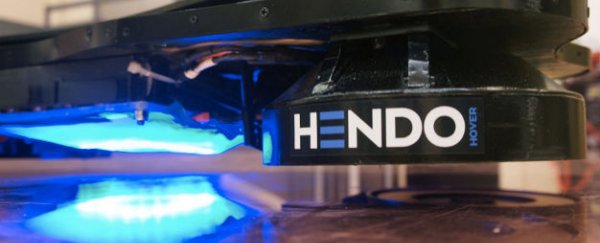We might've been introduced to the concept of a hoverboard way back in 1989's Back to the Future Part II, but decades later scientists are still struggling to bring the technology to reality. The difficulty is linked to what's known as Earnshaw's theorem, which basically states that when magnets are repelling each other, they're going to be super-tough to balance.
One way to mitigate this, says Conor Dougherty at The New York Times, is to have a magnetic hoverboard restricted to a track to keep it in place. This is what US-based couple Jill and Greg Henderson of the technology start-up Arx Pax have done to create the world's first functional hoverboard. Named the Hendo Hoverboard, the device is able to support a rider weighing up to 136 kg (300 pounds) and keep them floating about an inch above the ground.
"The hoverboard is just the first step, it's a proof of concept," Greg Henderson told Christine Kewitz at Motherboard. "It's the simplest way of demonstrating our technology in a way everyone can understand."
The Hendo Hoverboard is fitted with four disc-shaped motors, which produce a magnetic field that repels the board away from the ground below. Just like floating Maglev trains, this hoverboard uses what's known as Magnetic Field Architecture (MFA), which means the magnetic field only reacts to certain materials, such as copper or aluminium. So while this hoverboard won't be able to float you over stretches of water or down to your corner store any time soon, you'll be able to ride one around a specially built 'hoverboard park'.
Financed as part of a Kickstarter project, early supporters will be able to secure their own Hendo Hoverboard for US$10,000, but DIY dev-kits will also be available for $300 each, so enthusiasts can build and experiment with their own version.
So how does the thing feel to ride, I hear you ask? Lucky for us, Sean Buckley from Engadgethad the opportunity to ride a Hendo Hoverboard and described his experience:
"The levitating board wiggled slightly under my 200-pound [90-kg] frame, but maintained its altitude (a mere inch or so) without visible strain. Arx Pax tells me that the current prototype can easily support 300 pounds and future versions will be able to hold up to 500 pounds [226 kg] without issue."
The one-and-only Buzz Aldrin also gave it a spin last week.
While the Hendersons are now working on getting their hoverboard to work with other surfaces, their ultimate goal would be to invent some kind of technology that can levitate a building above its foundations in an emergency, such as during an earthquake. "It came from the idea of hovering a building out of harm's way," Greg told Buckley at Engadget. "If you can levitate a train that weighs 50,000 kilograms, why not a house?"
Sources: Motherboard, Engadget, The New York Times
